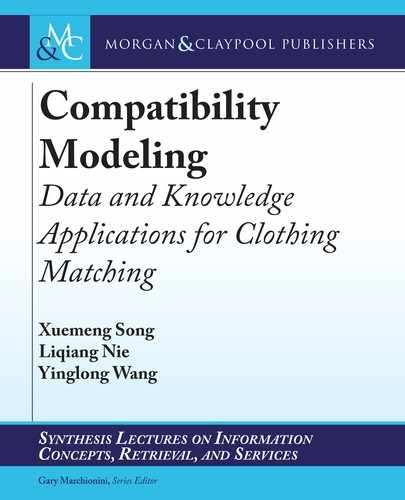
27
C H A P T E R 4
Knowledge-Guided
Compatibility Modeling
4.1 INTRODUCTION
Beyond the pure data-driven compatibility modeling as introduced in Chapter 3, this chapter
presents the knowledge-guided compatibility modeling. As a matter of fact, most existing re-
searches mainly rely on the deep neural networks to extract the effective representations for fash-
ion items to tackle the clothing matching problem, due to their impressive advances in various
research domains, including the image classification, speech recognition, and machine transla-
tion. However, as pure data-driven methods, neural networks not only suffer from the poor in-
terpretability but also overlook the value of human knowledge. Especially, as an essential aspect
of people’s daily life, the clothing matching domain has accumulated various valuable knowl-
edge, i.e., the matching rules. Although they may be of high subjectivity, certain matching rules
have been widely accepted by the public as common sense. For example, tank tops would go bet-
ter with shorts instead of the dress, while silk tops better avoid the knit bottoms. erefore, it is
highly desirable to devise an effective model to seamlessly incorporate such domain knowledge
into the pure data-driven learning methods and hence boost the matching performance.
In this work, we aim to investigate the practical fashion problem of clothing matching by
leveraging both the deep neural networks and the rich human knowledge in fashion domain. In
fact, the problem we pose here can be cast as the compatibility modeling between the comple-
mentary fashion items, such as tops and bottoms. However, comprehensively model the com-
patibility between fashion items from both the data-driven and knowledge-driven perspectives
is non-trivial due to the following challenges: (1) the human knowledge pertaining to fashion
is usually implicitly conveyed by the compositions of fashion experts, which makes the domain
knowledge unstructured and fuzzy. erefore, how to construct a set of structured knowledge
rules for the clothing matching constitutes a tough challenge; (2) how to seamlessly encode such
knowledge rules into the pure data-driven learning framework and enable the model to learn
from not only the specific data but also the general rules poses another challenge for us; and (3)
for different samples, knowledge rules may present different levels of confidence and hence pro-
vide different levels of guidance. For example, as can be seen from Figure 4.1, both compositions
satisfy the rule “stripe tops can go with stripe bottoms” according to their contextual metadata.
However, obviously, the given rule should impose more regularization toward the example of
..................Content has been hidden....................
You can't read the all page of ebook, please click here login for view all page.
